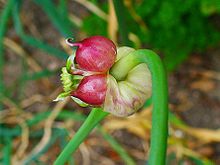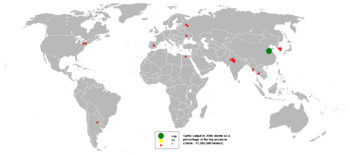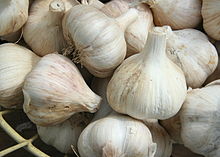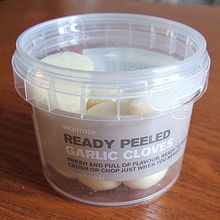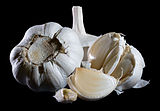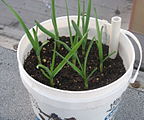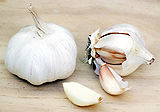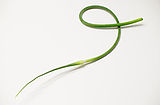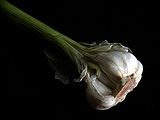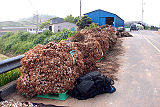- Garlic
-
For other uses, see Garlic (disambiguation).
Garlic 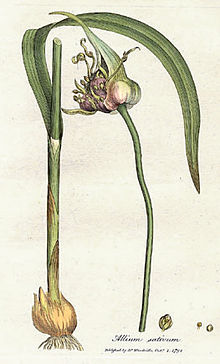
Allium sativum, known as garlic, from William Woodville, Medical Botany, 1793. Scientific classification 
Kingdom: Plantae clade: Angiosperms clade: Monocots Order: Asparagales Family: Amaryllidaceae Subfamily: Allioideae Genus: Allium Species: A. sativum Binomial name Allium sativum
L.Allium sativum, commonly known as garlic, is a species in the onion genus, Allium. Its close relatives include the onion, shallot, leek, chive,[1] and rakkyo.[2] Dating back over 6,000 years, garlic is native to central Asia,[3] and has long been a staple in the Mediterranean region, as well as a frequent seasoning in Asia, Africa, and Europe. It was known to Ancient Egyptians, and has been used throughout its history for both culinary and medicinal purposes.[4]
Contents
Origin and major types
The ancestry of cultivated garlic is not definitively established. According to Zohary and Hopf,[5] "A difficulty in the identification of its wild progenitor is the sterility of the cultivars", though it is thought to be descendent from the species Allium longicuspis, which grows wild in central and southwestern Asia.[6][7] Allium sativum grows in the wild in areas where it has become naturalised. The "wild garlic", "crow garlic", and "field garlic" of Britain are members of the species Allium ursinum, Allium vineale, and Allium oleraceum, respectively. In North America, Allium vineale (known as "wild garlic" or "crow garlic") and Allium canadense, known as "meadow garlic" or "wild garlic" and "wild onion", are common weeds in fields.[8] One of the best-known "garlics", the so-called elephant garlic, is actually a wild leek (Allium ampeloprasum), and not a true garlic. Single clove garlic (also called pearl or solo garlic) originated in the Yunnan province of China.
European garlic
There are a number of garlics with Protected Geographical Status in Europe; these include:
- Aglio Bianco Polesano from Veneto, Italy (PDO)
- Aglio di Voghiera from Ferrara, Emilia-Romagna, Italy (PDO)
- Ail blanc de Lomagne from Lomagne in the Gascony area of France (PGI)
- Ail de la Drôme from Drôme in France (PGI)
- Ail rose de Lautrec a rose/pink garlic from Lautrec in France (PGI)
- Ajo Morado de Las Pedroñeras a rose/pink garlic from Las Pedroñeras in Spain (PGI)
Varieties
While botanists classify garlic under the umbrella of the species, Allium sativum, there are also two main subspecies.[9]
- Ophioscorodon, or hard necked garlic, includes porcelain garlics, rocambole garlic, and purple stripe garlics.
- Sativum, or soft necked garlic, includes artichoke garlic, silverskin garlic, and creole garlic.
Bulb garlic is available in many forms, including fresh, frozen, dried, fermented (black garlic) and shelf stable products (in tubes or jars). In addition, see Culinary uses for other edible parts of the garlic plant.Cultivation
Garlic is easy to grow and can be grown year-round in mild climates. While sexual propagation of garlic is indeed possible, nearly all of the garlic in cultivation is propagated asexually, by planting individual cloves in the ground.[6] In cold climates, cloves are planted in the fall, about six weeks before the soil freezes, and harvested in late spring.[10] Garlic plants are usually very hardy, and are not attacked by many pests or diseases. Garlic plants are said to repel rabbits and moles.[2] Two of the major pathogens that attack garlic are nematodes and white rot disease, which remain in the soil indefinitely once the ground has become infected.[6] Garlic also can suffer from pink root, a typically nonfatal disease that stunts the roots and turns them pink or red.[11]
Garlic plants can be grown close together, leaving enough room for the bulbs to mature, and are easily grown in containers of sufficient depth. When selecting garlic for planting, it is important to pick large heads from which to separate cloves. Large cloves, along with proper spacing in the planting bed, will also improve head size. Garlic plants prefer to grow in a soil with a high organic material content, but are capable of growing in a wide range of soil conditions and pH levels.[6]
There are different types or subspecies of garlic, most notably hardneck garlic and softneck garlic. The latitude where the garlic is grown affects the choice of type as garlic can be day-length sensitive. Hardneck garlic is generally grown in cooler climates; softneck garlic is generally grown closer to the equator.[12][13]
Garlic scapes are removed to focus all the garlic's energy into bulb growth. The scapes can be eaten raw or cooked.[10][14]
Production trends
Garlic is grown globally, but China is by far the largest producer of garlic, with approximately 10.5 million tonnes (23 billion pounds) grown annually, accounting for over 77% of world output. India (4.1%) and South Korea (2%) follow, with Egypt and Russia (1.6%) tied in fourth place and the United States (where garlic is grown in every state except for Alaska) in sixth place (1.4%).[15] This leaves 16% of global garlic production in countries that each produce less than 2% of global output. Much of the garlic production in the United States is centered in Gilroy, California, which calls itself the "garlic capital of the world".[16]
Top 10 garlic producers — 11 June 2008 Country Production (tonnes) Footnote  China
China12,088,000 F  India
India645,000 F  South Korea
South Korea325,000 F  Egypt
Egypt258,608 F  Russia
Russia254,000 F  United States
United States221,810  Spain
Spain142,400  Argentina
Argentina140,000 F  Myanmar
Myanmar128,000 F  Ukraine
Ukraine125,000 F World 15,686,310 A No symbol = official figure, P = official figure, F = FAO estimate, *= unofficial/semiofficial/mirror data,
C = calculated figure, A = aggregate (may include official, semiofficial, or estimates).
Uses
Culinary uses
 Garlic being crushed using a garlic press
Garlic being crushed using a garlic press
Garlic is widely used around the world for its pungent flavor as a seasoning or condiment.
The garlic plant's bulb is the most commonly used part of the plant. With the exception of the single clove types, garlic bulbs are normally divided into numerous fleshy sections called cloves. Garlic cloves are used for consumption (raw or cooked) or for medicinal purposes. They have a characteristic pungent, spicy flavor that mellows and sweetens considerably with cooking.[17]
Other parts of the garlic plant are also edible. The leaves and flowers (bulbils) on the head (spathe) are sometimes eaten. They are milder in flavor than the bulbs,[2] and are most often consumed while immature and still tender. Immature garlic is sometimes pulled, rather like a scallion, and sold as "green garlic".[18] When green garlic is allowed to grow past the "scallion" stage, but not permitted to fully mature, it may produce a garlic "round", a bulb like a boiling onion, but not separated into cloves like a mature bulb.[19] Additionally, the immature flower stalks (scapes) of the hardneck and elephant types are sometimes marketed for uses similar to asparagus in stir-fries.[6]
Inedible or rarely eaten parts of the garlic plant include the "skin" and root cluster. The papery, protective layers of "skin" over various parts of the plant are generally discarded during preparation for most culinary uses, though in Korea immature whole heads are sometimes prepared with the tender skins intact.[20] The root cluster attached to the basal plate of the bulb is the only part not typically considered palatable in any form.
Garlic is a fundamental component in many or most dishes of various regions, including eastern Asia, South Asia, Southeast Asia, the Middle East, northern Africa, southern Europe, and parts of South and Central America. The flavour varies in intensity and aroma with the different cooking methods. It is often paired with onion, tomato, or ginger. The parchment-like skin is much like the skin of an onion, and is typically removed before using in raw or cooked form. An alternative is to cut the top off the bulb, coat the cloves by dribbling olive oil (or other oil-based seasoning) over them, and roast them in an oven. Garlic softens and can be extracted from the cloves by squeezing the (root) end of the bulb, or individually by squeezing one end of the clove. In Korea, heads of garlic are fermented at high temperature; the resulting product, called black garlic, is sweet and syrupy, and is now being sold in the United States, United Kingdom and Australia.
Garlic may be applied to breads to create a variety of classic dishes, such as garlic bread, garlic toast, bruschetta, crostini and canapé.
 Garlic being rubbed onto a slice of bread
Garlic being rubbed onto a slice of breadOils can be flavored with garlic cloves. These infused oils are used to season all categories of vegetables, meats, breads and pasta.
In some cuisines, the young bulbs are pickled for three to six weeks in a mixture of sugar, salt, and spices. In eastern Europe, the shoots are pickled and eaten as an appetizer.
Immature scapes are tender and edible. They are also known as "garlic spears", "stems", or "tops". Scapes generally have a milder taste than the cloves. They are often used in stir frying or braised like asparagus.[14] Garlic leaves are a popular vegetable in many parts of Asia. The leaves are cut, cleaned, and then stir-fried with eggs, meat, or vegetables.
Mixing garlic with egg yolks and olive oil produces aioli. Garlic, oil, and a chunky base produce skordalia. Blending garlic, almond, oil, and soaked bread produces ajoblanco.
Garlic powder has a different taste from fresh garlic. If used as a substitute for fresh garlic, 1/8 teaspoon of garlic powder is equivalent to one clove of garlic.
Storage
Domestically, garlic is stored warm [above 18 °C (64 °F)] and dry to keep it dormant (so it does not sprout). It is traditionally hung; softneck varieties are often braided in strands called plaits or grappes. Peeled cloves may be stored in wine or vinegar in the refrigerator.[21] Commercially, garlic is stored at 0 °C (32 °F), in a dry, low-humidity environment.[22] Garlic will keep longer if the tops remain attached.[6]
Garlic is often kept in oil to produce flavoured oil; however, the practice requires measures to be taken to prevent the garlic from spoiling. Untreated garlic kept in oil can support the growth of Clostridium botulinum which causes the deadly botulism illness; refrigeration will not assure the safety of garlic kept in oil. To reduce this risk, the oil should be refrigerated and used within one week. Commercially prepared oils are widely available. Manufacturers add acids and/or other chemicals to eliminate the risk of botulism in their products.[23] Two outbreaks of botulism related to garlic stored in oil have been reported.[24][25]
Historical use
Garlic has been used as both food and medicine in many cultures for thousands of years, dating at least as far back as when the Giza pyramids were built. Garlic is still grown in Egypt, but the Syrian variety is the kind most esteemed now (see Rawlinson's Herodotus, 2.125).
Garlic is mentioned in the Bible and the Talmud. Hippocrates, Galen, Pliny the Elder, and Dioscorides all mention the use of garlic for many conditions, including parasites, respiratory problems, poor digestion, and low energy. Its use in China was first mentioned in AD 510.
It was consumed by ancient Greek and Roman soldiers, sailors, and rural classes (Virgil, Ecologues ii. 11), and, according to Pliny the Elder (Natural History xix. 32), by the African peasantry. Galen eulogizes it as the "rustic's theriac" (cure-all) (see F. Adams' Paulus Aegineta, p. 99), and Alexander Neckam, a writer of the 12th century (see Wright's edition of his works, p. 473, 1863), recommends it as a palliative for the heat of the sun in field labor.
In the account of Korea's establishment as a nation, gods were said to have given mortal women with bear and tiger temperaments an immortal's black garlic before mating with them.[citation needed][vague] This is a genetically unique, six-clove garlic that was to have given the women supernatural powers and immortality. This garlic is still cultivated in a few mountain areas today.
In his Natural History, Pliny gives an exceedingly long list of scenarios in which it was considered beneficial (N.H. xx. 23). Dr. T. Sydenham valued it as an application in confluent smallpox, and, says Cullen (Mat. Med. ii. p. 174, 1789), found some dropsies cured by it alone. Early in the 20th century, it was sometimes used in the treatment of pulmonary tuberculosis or phthisis.
 Harvesting garlic, from Tacuinum sanitatis, 15th century (Bibliothèque nationale)
Harvesting garlic, from Tacuinum sanitatis, 15th century (Bibliothèque nationale)
Garlic was rare in traditional English cuisine (though it is said to have been grown in England before 1548) and has been a much more common ingredient in Mediterranean Europe. Garlic was placed by the ancient Greeks on the piles of stones at crossroads, as a supper for Hecate (Theophrastus, Characters, The Superstitious Man). A similar practice of hanging garlic, lemon and red chilli at the door or in a shop to ward off potential evil, is still very common in India.[26] According to Pliny, garlic and onions were invoked as deities by the Egyptians at the taking of oaths. (Pliny also stated garlic demagnetizes lodestones, which is not factual.)[27] The inhabitants of Pelusium, in lower Egypt (who worshiped the onion), are said to have had an aversion to both onions and garlic as food.
To prevent the plant from running to leaf, Pliny (N.H. xix. 34) advised bending the stalk downward and covering with earth; seeding, he observes, may be prevented by twisting the stalk (by "seeding", he most likely meant the development of small, less potent bulbs).
Medicinal use and health benefits
Garlic, raw Nutritional value per 100 g (3.5 oz) Energy 623 kJ (149 kcal) Carbohydrates 33.06 g - Sugars 1.00g - Dietary fiber 2.1 g Fat 0.5 g Protein 6.39 g - beta-carotene 5 μg (0%) Thiamine (vit. B1) 0.2 mg (17%) Riboflavin (vit. B2) 0.11 mg (9%) Niacin (vit. B3) 0.7 mg (5%) Pantothenic acid (B5) 0.596 mg (12%) Vitamin B6 1.235 mg (95%) Folate (vit. B9) 3 μg (1%) Vitamin C 31.2 mg (38%) Calcium 181 mg (18%) Iron 1.7 mg (13%) Magnesium 25 mg (7%) Phosphorus 153 mg (22%) Potassium 401 mg (9%) Sodium 17 mg (1%) Zinc 1.16 mg (12%) Manganese 1.672 mg Selenium 14.2 μg Percentages are relative to US recommendations for adults.
Source: USDA Nutrient DatabaseIn in vitro studies, garlic has been found to have antibacterial, antiviral, and antifungal activity. However, these actions are less clear in vivo. Garlic is also claimed to help prevent heart disease (including atherosclerosis, high cholesterol, and high blood pressure) and cancer.[28] Garlic is used to prevent certain types of cancer, including stomach and colon cancers. In fact, countries where garlic is consumed in higher amounts, because of traditional cuisine, have been found to have a lower prevalence of cancer.[29] Animal studies, and some early research studies in humans, have suggested possible cardiovascular benefits of garlic. A Czech study found garlic supplementation reduced accumulation of cholesterol on the vascular walls of animals.[30] Another study had similar results, with garlic supplementation significantly reducing aortic plaque deposits of cholesterol-fed rabbits.[31] Another study showed supplementation with garlic extract inhibited vascular calcification in human patients with high blood cholesterol.[32] The known vasodilative effect of garlic is possibly caused by catabolism of garlic-derived polysulfides to hydrogen sulfide in red blood cells (RBCs), a reaction that is dependent on reduced thiols in or on the RBC membrane. Hydrogen sulfide is an endogenous cardioprotective vascular cell-signaling molecule.[33]
A randomized clinical trial funded by the National Institutes of Health (NIH) in the United States and published in the Archives of Internal Medicine in 2007 found the consumption of garlic in any form did not reduce blood cholesterol levels in patients with moderately high baseline cholesterol levels.[34][35] According to Heart.org, "despite decades of research suggesting that garlic can improve cholesterol profiles, a new NIH-funded trial found absolutely no effects of raw garlic or garlic supplements on LDL, HDL, or triglycerides... The findings underscore the hazards of meta-analyses made up of small, flawed studies and the value of rigorously studying popular herbal remedies". In an editorial regarding the initial report's findings, two physicians from Weill Cornell Medical College of Cornell University, pointed out that there may "be effects of garlic on atherosclerosis specifically that were not picked up in the study".[36]
Allium sativum has been found to reduce platelet aggregation[37][38][39][40] and hyperlipidemia.[40][41][42]
In 2007, the BBC reported Allium sativum may have other beneficial properties, such as preventing and fighting the common cold.[43] This assertion has the backing of long tradition in herbal medicine, which has used garlic for hoarseness and coughs.[44] The Cherokee also used it as an expectorant for coughs and croup.[45]
Garlic is also alleged to help regulate blood sugar levels. Regular and prolonged use of therapeutic amounts of aged garlic extracts lower blood homocysteine levels and has been shown to prevent some complications of diabetes mellitus.[46][47] People taking insulin should not consume medicinal amounts of garlic without consulting a physician.
In 1858, Louis Pasteur observed garlic's antibacterial activity, and it was used as an antiseptic to prevent gangrene during World War I and World War II.[48] More recently, it has been found from a clinical trial that a mouthwash containing 2.5% fresh garlic shows good antimicrobial activity, although the majority of the participants reported an unpleasant taste and halitosis.[49]
Garlic cloves are used as a remedy for infections (especially chest problems), digestive disorders, and fungal infections such as thrush.[50][51] Garlic can be used as a disinfectant because of its bacteriostatic and bacteriocidal properties.[4]
Garlic has been found to enhance thiamin absorption, and therefore reduces the likelihood for developing the thiamin deficiency beriberi.[52]
In 1924, it was found to be an effective way to prevent scurvy, because of its high vitamin C content.[52]
Garlic has been used reasonably successfully in AIDS patients to treat Cryptosporidium in an uncontrolled study in China.[53] It has also been used by at least one AIDS patient to treat toxoplasmosis, another protozoal disease.[54]
Garlic supplementation has been shown to boost testosterone levels in rats fed a high protein diet.[55]
A 2010 double-blind, parallel, randomised, placebo-controlled trial, involving 50 patients whose routine clinical records in general practice documented treated but uncontrolled hypertension, concluded, "Our trial suggests that aged garlic extract is superior to placebo in lowering systolic blood pressure similarly to current first line medications in patients with treated but uncontrolled hypertension."[56]
Other uses
The sticky juice within the bulb cloves is used as an adhesive in mending glass and porcelain in China.[2]
Adverse effects and toxicology
Garlic is known for causing halitosis, as well as causing sweat to have a pungent 'garlicky' smell, which is caused by allyl methyl sulfide (AMS). AMS is a gas which is absorbed into the blood during the metabolism of garlic; from the blood it travels to the lungs[citation needed] (and from there to the mouth, causing bad breath) and skin, where it is exuded through skin pores. Washing the skin with soap is only a partial and imperfect solution to the smell. Studies have shown sipping milk at the same time as consuming garlic can significantly neutralize bad breath.[57] Mixing garlic with milk in the mouth before swallowing reduced the odor better than drinking milk afterward.[57] Plain water, mushrooms and basil may also reduce the odor; the mix of fat and water found in milk, however, was the most effective.[57]
The green, dry 'folds' in the center of the garlic clove are especially pungent. The sulfur compound allicin, produced by crushing or chewing fresh garlic, produces other sulfur compounds: ajoene, allyl sulfides, and vinyldithiins. Aged garlic lacks allicin, but may have some activity due to the presence of S-allylcysteine.
In a rat study allicin was found to be an activator of TRPA1. The neurons released neurotransmitters in the spinal cord to generate pain signals and released neuropeptides at the site of sensory nerve activation, resulting in vasodilation, as well as inflammation.[58] Allicin is released only by crushing or chewing raw garlic and cannot be formed from cooked garlic.
Some people suffer from allergies to garlic and other plants in the allium family. Symptoms can include irritable bowel, diarrhea, mouth and throat ulcerations, nausea, breathing difficulties, and, in rare cases, anaphylaxis. Garlic-sensitive patients show positive tests to diallyl disulfide, allylpropyldisulfide, allylmercaptan and allicin, all of which are present in garlic. People who suffer from garlic allergies will often be sensitive to many plants, including onions, garlic, chives, leeks, shallots, garden lilies, ginger, and bananas.
It thins the blood (as does aspirin);[59] this had caused very high quantities of garlic and garlic supplements to be linked with an increased risk of bleeding, particularly during pregnancy and after surgery and childbirth,[60][61] although culinary quantities are safe for consumption.
Several reports of serious burns resulting from garlic being applied topically for various purposes, including naturopathic uses and acne treatment, indicate care must be taken for these uses, usually testing a small area of skin using a very low concentration of garlic.[62] On the basis of numerous reports of such burns, including burns to children, topical use of raw garlic, as well as insertion of raw garlic into body cavities, is discouraged. In particular, topical application of raw garlic to young children is not advisable.[63] The side effects of long-term garlic supplementation, if any exist, are largely unknown, and no FDA-approved study has been performed. However, garlic has been consumed for several thousand years without any adverse long-term effects, suggesting modest quantities of garlic pose, at worst, minimal risks to normal individuals. Possible side effects include gastrointestinal discomfort, sweating, dizziness, allergic reactions, bleeding, and menstrual irregularities.[61] The safety of garlic supplements had not been determined for children.;[64] some breastfeeding mothers have found their babies slow to feed and have noted a garlic odour coming from their baby when they have consumed garlic.[60][64]
Garlic may interact with warfarin, antiplatelets, saquinavir, antihypertensives, calcium channel blockers, quinolone family of antibiotics such as Cipro,and hypoglycemic drugs, as well as other medications.[60] Members of the alium family might be toxic to cats or dogs.[65] Some degree of liver toxicity has been demonstrated in rats, particularly in extremely large quantities exceeding those that a rat would consume under normal situations.[66]
Properties
When crushed, Allium sativum yields allicin, an antibiotic[67] and antifungal compound (phytoncide). It has been claimed that it can be used as a home remedy to help speed recovery from strep throat or other minor ailments because of its antibiotic properties[citation needed]. It also contains the sulfur-containing compounds alliin, ajoene, diallylsulfide, dithiin, S-allylcysteine, and enzymes, B vitamins, proteins, minerals, saponins, flavonoids, and Maillard reaction products, which are not sulfur-containing compounds. Furthermore, a phytoalexin (allixin) was found, a nonsulfur compound with a γ-pyrone skeleton structure with antioxidant effects, antimicrobial effects,[68] antitumor promoting effects,[69] inhibition of aflatoxin B2 DNA binding,[69] and neurotrophic effects. Allixin showed an antitumor promoting effect in vivo, inhibiting skin tumor formation by TPA and DMBA initiated mice.[69] Analogs of this compound have exhibited antitumor promoting effects in in vitro experimental conditions. Herein, allixin and/or its analogs may be expected useful compounds for cancer prevention or chemotherapy agents for other diseases.
The composition of the bulbs is approximately 84.09% water, 13.38% organic matter, and 1.53% inorganic matter, while the leaves are 87.14% water, 11.27% organic matter, and 1.59% inorganic matter.[70][71]
The phytochemicals responsible for the sharp flavor of garlic are produced when the plant's cells are damaged. When a cell is broken by chopping, chewing, or crushing, enzymes stored in cell vacuoles trigger the breakdown of several sulfur-containing compounds stored in the cell fluids. The resultant compounds are responsible for the sharp or hot taste and strong smell of garlic. Some of the compounds are unstable and continue to react over time. Among the members of the onion family, garlic has by far the highest concentrations of initial reaction products, making garlic much more potent than onions, shallots, or leeks.[72] Although many humans enjoy the taste of garlic, these compounds are believed to have evolved as a defensive mechanism, deterring animals such as birds, insects, and worms from eating the plant.[73]
A large number of sulfur compounds contribute to the smell and taste of garlic. Diallyl disulfide is believed to be an important odor component. Allicin has been found to be the compound most responsible for the "hot" sensation of raw garlic. This chemical opens thermotransient receptor potential channels that are responsible for the burning sense of heat in foods. The process of cooking garlic removes allicin, thus mellowing its spiciness.[74]
Because of its strong odor, garlic is sometimes called the "stinking rose". When eaten in quantity, garlic may be strongly evident in the diner's sweat and breath the following day. This is because garlic's strong-smelling sulfur compounds are metabolized, forming allyl methyl sulfide. Allyl methyl sulfide (AMS) cannot be digested and is passed into the blood. It is carried to the lungs and the skin, where it is excreted. Since digestion takes several hours, and release of AMS several hours more, the effect of eating garlic may be present for a long time.
This well-known phenomenon of "garlic breath" is alleged to be alleviated by eating fresh parsley.[75] The herb is, therefore, included in many garlic recipes, such as pistou, persillade, and the garlic butter spread used in garlic bread. However, since the odour results mainly from digestive processes placing compounds such as AMS in the blood, and AMS is then released through the lungs over the course of many hours, eating parsley provides only a temporary masking. One way of accelerating the release of AMS from the body is the use of a sauna.[citation needed]
Because of the AMS in the bloodstream, it is believed by some to act as a mosquito repellent, but no clinically reported evidence suggests it is actually effective.[76]
Spiritual and religious perceptions
Garlic has been regarded as a force for both good and evil. According to Cassell's Dictionary of Superstitions, there is an Islamic myth that considers that after Satan left the Garden of Eden, garlic arose in his left footprint and onion in the right.[77] In Europe, many cultures have used garlic for protection or white magic, perhaps owing to its reputation as a potent preventative medicine.[78] Central European folk beliefs considered garlic a powerful ward against demons, werewolves, and vampires.[78] To ward off vampires, garlic could be worn, hung in windows, or rubbed on chimneys and keyholes.[79]
In connection with the odor associated with garlic, Islam views eating garlic and subsequently going to the mosque as inappropriate[80] because the smell from the mouth will irritate the fellow worshippers.
In both Hinduism and Jainism, garlic is considered to stimulate and warm the body and to increase one's desires. Some devout Hindus generally avoid using garlic and the related onion in the preparation of foods for religious festivities and events. Followers of the Jain religion avoid eating garlic and onion on a daily basis.
A belief among some sections of Hindus is that when Devas and Asuras fought for nectar during churning of the ocean of milk (Samundar mathan) in the other world, two Asuras were able to get access to nectar and had some quantity in their mouths in stealthy ways. Knowing Asuras' foul play the God made a cuff on heads of those Asuras before they could swallow it and as a result nector fell down on the earth from their mouths in drops which later grew as garlic and that is why the vegetable has such a wonderful medicinal properties.
In some Buddhist traditions, garlic - along with the other five "pungent spices" - is understood to stimulate sexual and aggressive drives to the detriment of meditation practice.[81]
Gallery

Garlic being hand harvested, loaded onto a truck, and ready for transport to a distribution center in rural Goheung county, South Jeolla province, South Korea See also
- Allistatin, a natural antibiotic found in garlic and onions.
- International Code of Nomenclature for Cultivated Plants
- Phytoalexin, an antimicrobial substance synthesized from garlic.
- Garlic Is as Good as Ten Mothers. Directed by Les Blank.
- Herbalism
- Garlic festival
- Pyruvate scale
References
- ^ Block, E. (2010). Garlic and Other Alliums: The Lore and the Science. Royal Society of Chemistry. ISBN 0854041907. http://books.google.com/?id=6AB89RHV9ucC&printsec=frontcover.
- ^ a b c d "AllergyNet — Allergy Advisor Find". Allallergy.net. http://www.allallergy.net/fapaidfind.cfm?cdeoc=684. Retrieved 2010-04-14.
- ^ Ensminger, Audrey H. (1994). Foods & nutrition encyclopedia, Volume 1. CRC Press, 1994. ISBN 0849389801. p. 750
- ^ a b Gualtiero Simonetti (1990). Stanley Schuler. ed. Simon & Schuster's Guide to Herbs and Spices. Simon & Schuster, Inc. ISBN 0-671-73489-X.
- ^ Daniel Zohary and Maria Hopf, Domestication of plants in the Old World, third edition (Oxford: University Press, 2000), p. 197
- ^ a b c d e f "Small Farm News Archive". Sfc.ucdavis.edu. http://www.sfc.ucdavis.edu/pubs/sfnews/archive/95071.htm. Retrieved 2010-04-14.
- ^ Salunkhe and Kradam p. 397
- ^ McGee p. 112
- ^ "The Garlic Family Tree and Where Garlic Came from". http://www.gourmetgarlicgardens.com/overview.htm.
- ^ a b "The Cult of the Cloves". New York Times. September 29, 2010. http://www.nytimes.com/2010/09/30/garden/30garden.html?hpw=&pagewanted=all. Retrieved 2010-10-05. "You sow it in fall, not spring. The plant often forms strange curling stalks, or 'scapes', with odd nodules called umbels. These rococo growths contain their own minicloves called bulbils, a term that sounds like a playground insult."
- ^ "UC IPM: UC Management Guidelines for Pink Root on Onion and Garlic". Ipm.ucdavis.edu. http://www.ipm.ucdavis.edu/PMG/r584100711.html. Retrieved 2010-04-14.
- ^ "Farmers Forum — It probably came from Gilroy | Warren Reporter". NJ.com. http://www.nj.com/warrenreporter/index.ssf/2008/12/farmers_forum_it_probably_came.html. Retrieved 2009-12-06.
- ^ "The Medicinal Uses of Garlic | Natural Holistic Health Blog". Natural-holistic-health.com. 2009-06-20. http://www.natural-holistic-health.com/alternative-therapies/herbs-for-health/medicinal-garlic/. Retrieved 2009-12-06.
- ^ a b "A Garlic Festival Without a Single Clove". New York Times. June 18, 2008. http://www.nytimes.com/2008/06/18/dining/18appe.html?scp=1&sq=garlic%20scapes&st=cse. Retrieved 2010-10-05. "Garlic scapes are pencil thin and exuberantly loopy, and emanate a clean and mildly garlicky scent. ... They had a gently spicy undertone and an exquisitely fresh green, mellow taste. Unlike regular garlic, which needs some kind of vehicle to carry its intense flavor to the mouth, scapes are self-sufficient; vegetable and aromatic all in one."
- ^ Economic Research Service, United States Department of Agriculture. Vegetables and Melons Outlook, October 19, 2006, p. 25. (The excerpt "Commodity Highlight: Garlic" (pp. 25–29) is available from Lewis & Clark College.)
- ^ "City of Gilroy: Community Profile". cityofgilroy.org. http://www.cityofgilroy.org/cityofgilroy/community/community_profile/default.aspx. Retrieved 2011-06-14.
- ^ Gernot Katzer (2005-02-23). "Spice Pages: Garlic (Allium sativum, garlick)". http://www.uni-graz.at/~katzer/engl/Alli_sat.html. Retrieved 2007-08-28.
- ^ Thompson, Sylvia. The Kitchen Garden. Bantam Books, 1995, p. 144.
- ^ Thompson, Sylvia. The Kitchen Garden. Bantam Books, 1995, p. 145.
- ^ Amanda. "Glossary of Foods and Food Terms in Korea". Food-links.com. http://www.food-links.com/countries/korea/food-terms-korea.php. Retrieved 2010-04-14.
- ^ GARLIC: Safe Methods to Store, Preserve and Enjoy
- ^ "Garlic Produce Facts". Postharvest.ucdavis.edu. 2009-02-10. http://postharvest.ucdavis.edu/Produce/ProduceFacts/Veg/garlic.shtml. Retrieved 2009-12-06.
- ^ "It's Your Health — Garlic-In-Oil". Hc-sc.gc.ca. 2009-02-18. http://www.hc-sc.gc.ca/iyh-vsv/food-aliment/garlic-ail_e.html. Retrieved 2009-12-06.
- ^ CSU SafeFood Newsletter, Summer 2005 - Vol 9 No. 4 - Botulinum Toxin: Friend or Foe
- ^ Health Canada - Garlic-in-Oil
- ^ Eichstaedt, K.C. (2008), Superstitions About Garlic: What Does it Do Besides Ward Off Vampires?
- ^ Lehoux, Daryn (2003). "Tropes, Facts, and Empiricism" (PDF). Perspectives on Science 11 (3): 326–345. doi:10.1162/106361403773062678. http://personalpages.manchester.ac.uk/staff/daryn.lehoux/Tropes.pdf.
- ^ University of Maryland Garlic
- ^ Teuscher E (2005). Medicinal Spices (1 ed.). Stuttgart: Medpharm.
- ^ Sovová M, Sova P (May 2004). "[Pharmaceutical importance of Allium sativum L. 5. Hypolipemic effects in vitro and in vivo]" (in Czech). Ceska Slov Farm 53 (3): 117–23. PMID 15218732.
- ^ Durak I, Oztürk HS, Olcay E, Güven C (2002). "Effects of garlic extract supplementation on blood lipid and antioxidant parameters and atherosclerotic plaque formation process in cholesterol-fed rabbits". J Herb Pharmacother 2 (2): 19–32. doi:10.1300/J157v02n02_03. PMID 15277094.
- ^ Durak I, Kavutcu M, Aytaç B, et al (June 2004). "Effects of garlic extract consumption on blood lipid and oxidant/antioxidant parameters in humans with high blood cholesterol". J. Nutr. Biochem. 15 (6): 373–7. doi:10.1016/j.jnutbio.2004.01.005. PMID 15157944.
- ^ Benavides GA, Squadrito GL, Mills RW, et al (November 2007). "Hydrogen sulfide mediates the vasoactivity of garlic". Proc. Natl. Acad. Sci. U.S.A. 104 (46): 17977–82. Bibcode 2007PNAS..10417977B. doi:10.1073/pnas.0705710104. PMC 2084282. PMID 17951430. http://www.pubmedcentral.nih.gov/articlerender.fcgi?tool=pmcentrez&artid=2084282.
- ^ Charlson M, McFerren M (February 2007). "Garlic: what we know and what we don't know". Arch. Intern. Med. 167 (4): 325–6. doi:10.1001/archinte.167.4.325. PMID 17325291. http://archinte.ama-assn.org/cgi/content/extract/167/4/325.
- ^ Gardner CD, Lawson LD, Block E, et al (February 2007). "Effect of raw garlic vs commercial garlic supplements on plasma lipid concentrations in adults with moderate hypercholesterolemia: a randomized clinical trial". Arch. Intern. Med. 167 (4): 346–53. doi:10.1001/archinte.167.4.346. PMID 17325296. http://archinte.ama-assn.org/cgi/content/full/167/4/346.
- ^ Goodbye, garlic? Randomized controlled trial of raw garlic and supplements finds no effect on lipids. Retrieved 27 February 2007.
- ^ Rahman K (November 2007). "Effects of garlic on platelet biochemistry and physiology". Mol Nutr Food Res 51 (11): 1335–44. doi:10.1002/mnfr.200700058. PMID 17966136.
- ^ Chan KC, Yin MC, Chao WJ (March 2007). "Effect of diallyl trisulfide-rich garlic oil on blood coagulation and plasma activity of anticoagulation factors in rats". Food Chem Toxicol 45 (3): 502–7. doi:10.1016/j.fct.2006.10.005. PMID 17123684.
- ^ Borrelli F, Capasso R, Izzo AA (November 2007). "Garlic (Allium sativum L.): adverse effects and drug interactions in humans". Mol Nutr Food Res 51 (11): 1386–97. doi:10.1002/mnfr.200700072. PMID 17918162.
- ^ a b Steiner M, Lin RS (June 1998). "Changes in platelet function and susceptibility of lipoproteins to oxidation associated with administration of aged garlic extract". J Cardiovasc Pharmacol 31 (6): 904–8. doi:10.1097/00005344-199806000-00014. PMID 9641475.
- ^ Kojuri J, Vosoughi AR, Akrami M (March 2007). "Effects of Anethum graveolens and garlic on lipid profile in hyperlipidemic patients". Lipids Health Dis 1 (6): 5. doi:10.1186/1476-511X-6-5. PMC 1821028. PMID 17328819. http://www.pubmedcentral.nih.gov/articlerender.fcgi?tool=pmcentrez&artid=1821028.
- ^ Mader FH (October 1990). "Treatment of hyperlipidaemia with garlic-powder tablets. Evidence from the German Association of General Practitioners' multicentric placebo-controlled double-blind study". Arzneimittelforschung 40 (10): 1111–6. PMID 2291748.
- ^ Garlic 'prevents common cold' 2007
- ^ Grieve, Maud. (Mrs.). Garlic. A Modern Herbal. Hypertext version of the 1931 edition. Accessed: December 18, 2006.
- ^ Hamel, Paul B. and Mary U. Chiltoskey 1975 Cherokee Plants and Their Uses -- A 400 Year History. Sylva, N.C. Herald Publishing Co. (p. 35)
- ^ People with diabetes should say 'yes' to garlic by Patricia Andersen-Parrado, Better Nutrition, Sept 1996
- ^ Garlic - University of Maryland Medical Center
- ^ Health effects of garlic American Family Physician by Ellen Tattelman, July 1, 2005
- ^ Groppo, F.; Ramacciato, J.; Motta, R.; Ferraresi, P.; Sartoratto, A. (2007). "Antimicrobial activity of garlic against oral streptococci". Int. J. Dent. Hyg. 5 (2): 109–115. doi:10.1111/j.1601-5037.2007.00230.x.
- ^ Lemar KM, Passa O, Aon MA, et al (October 2005). "Allyl alcohol and garlic (Allium sativum) extract produce oxidative stress in Candida albicans". Microbiology (Reading, Engl.) 151 (Pt 10): 3257–65. doi:10.1099/mic.0.28095-0. PMC 2711876. PMID 16207909. http://mic.sgmjournals.org/cgi/content/full/151/10/3257.
- ^ Shuford JA, Steckelberg JM, Patel R (January 2005). "Effects of fresh garlic extract on Candida albicans biofilms". Antimicrob. Agents Chemother. 49 (1): 473. doi:10.1128/AAC.49.1.473.2005. PMC 538912. PMID 15616341. http://aac.asm.org/cgi/content/full/49/1/473.
- ^ a b Jones W, Goebel RJ (2001). "Garlic and Health". In Watson RR. Vegetables, Fruits, and Herbs in Health Promotion. Boca Raton: CRC Press. pp. 205–216.
- ^ Fareed G, Scolaro M, Jordan W, Sanders N, Chesson C, Slattery M, Long D, Castro C. The use of a high-dose garlic preparation for the treatment of Cryptosporidium parvum diarrhea. NLM Gateway. Retrieved December 7, 2007.
- ^ John S. James. Treatment Leads on Cryptosporidiosis: Preliminary Report on Opportunistic Infection, AIDS TREATMENT NEWS No. 049 - January 29, 1988. Retrieved December 7, 2007.
- ^ Oi Y, Imafuku M, Shishido C, Kominato Y, Nishimura S, Iwai K. (2001). "Garlic supplementation increases testicular testosterone and decreases plasma corticosterone in rats fed a high protein diet". Journal of Nutrition 131 (8): 2150–6. PMID 11481410.
- ^ Ried, K.; Frank, O. R.; Stocks, N. P. (2010). "Aged garlic extract lowers blood pressure in patients with treated but uncontrolled hypertension: a randomised controlled trial". Maturitas 67 (2): 144–150. doi:10.1016/j.maturitas.2010.06.001. PMID 20594781.
- ^ a b c "Drinking a glass of milk can stop garlic breath". BBC News. August 31, 2010. http://www.bbc.co.uk/news/health-11138979. Retrieved August 31, 2010.
- ^ Fleischauer, A.T. and Arab, L. (2001) "Garlic and cancer: a critical review of the epidemiologic literature." J. Nutrition 131: 1032S-1040S
- ^ "Garlic - ''Allium sativum'' [NCCAM Herbs at a Glance]". Nccam.nih.gov. 2009-08-28. http://nccam.nih.gov/health/garlic/. Retrieved 2009-12-06.
- ^ a b c Hogg, Jennifer (2002-12-13). "Garlic Supplements" (PDF). Complementary Medicines Summary. UK Medicines Information, National Health Service. http://www.ukmi.nhs.uk/Med_info/documents/GarlicSuppsCMSFinal2.pdf. Retrieved 2007-07-07.
- ^ a b "MedlinePlus Herbs and Supplements: Garlic (''Allium sativum'' L.)". Nlm.nih.gov. 2009-08-26. http://www.nlm.nih.gov/medlineplus/druginfo/natural/patient-garlic.html. Retrieved 2009-12-06.
- ^ Baruchin AM, Sagi A, Yoffe B, Ronen M (November 2001). "Garlic burns". Burns 27 (7): 781–2. doi:10.1016/S0305-4179(01)00039-0. PMID 11600262. http://linkinghub.elsevier.com/retrieve/pii/S0305417901000390.
- ^ Garty BZ (March 1993). "Garlic burns". Pediatrics 91 (3): 658–9. PMID 8441577.
- ^ a b Mayo Clinic, garlic advisory
- ^ What you should know about household hazards to pets brochure by the American Veterinary Medical Association.
- ^ Alnaqeeb MA, Thomson M, Bordia T, Ali M (June 1996). "Histopathological effects of garlic on liver and lung of rats". Toxicol. Lett. 85 (3): 157–64. doi:10.1016/0378-4274(96)03658-2. PMID 8644128. http://linkinghub.elsevier.com/retrieve/pii/0378427496036582.
- ^ "Garlic: A natural antibiotic". ACM Modern Drug Discovery April 2002 Vol. 5, No. 4, p 12.. 2002-04-01. http://pubs.acs.org/subscribe/journals/mdd/v05/i04/html/04news4.html. Retrieved 2010-08-23.
- ^ Kodera Y., Matuura H., Yoshida S., Sumida T., Itakura Y., Fuwa T., Nishino H. (1989-01-30). "Allixin, a stress compound from garlic.". http://joi.jlc.jst.go.jp/JST.JLC/AID/6d45e46d45c048c9062c390a58734a7228bf?from=J-STAGE&type=list&lang=en. Retrieved 2009-01-30.
- ^ a b c Yamasaki T., Teel R. W., Lau B. H. (1991-08-01). "Effect of allixin, a phytoalexin produced by garlic, on mutagenesis, DNA-binding and metabolism of aflatoxin B1". http://joi.jlc.jst.go.jp/JST.JLC/AID/6d45e46d45c048c9062c390a58734a7c72bf?from=J-STAGE&type=list&lang=en. Retrieved 2009-01-30.
- ^ "agronomy". Lem.ch.unito.it. http://lem.ch.unito.it/didattica/infochimica/2006_aglio/pagine/agronomy.html. Retrieved 2009-12-06.
- ^ "Garlic — Article". Goldbamboo.com. 2006-07-22. http://www.goldbamboo.com/topic-t6335-a1-6Allium_sativum.html. Retrieved 2009-12-06.
- ^ McGee pp. 310–311
- ^ Macpherson et al. section "Conclusion"
- ^ Macpherson et al.
- ^ "garlic Definition in the Food Dictionary at". Epicurious.com. http://www.epicurious.com/tools/fooddictionary/entry?id=2677. Retrieved 2010-04-14.
- ^ "Mosquito Repellents". Edis.ifas.ufl.edu. http://edis.ifas.ufl.edu/IN419. Retrieved 2009-12-06.
- ^ Pickering, David (2003). Cassell's Dictionary of Superstitions. Sterling Publishing. ISBN 0-304-36561-0. p. 211
- ^ a b McNally, Raymond T (1994). In Search of Dracula. Houghton Mifflin. ISBN 0-395-65783-0. p. 120.
- ^ McNally p. 122; Pickering p. 211.
- ^ Bukhari, Volume 7, Book 65
- ^ "The Buddhist Diet". SFSU. http://online.sfsu.edu/~rone/Buddhism/BuddhismAnimalsVegetarian/Buddhist%20Diet.htm.
Bibliography
- Japanese garlic.にんにく専門のにんにく屋.jp[青森県産].
- Balch, P. A. (2000). Prescription for Nutritional Healing, 3rd ed. New York: Avery.
- Block, E. (1985). The chemistry of garlic and onions. Scientific American 252 (March): 114–9.
- Block E (1992). "The organosulfur chemistry of the genus Allium — implications for organic sulfur chemistry". Angewandte Chemie International Edition 104: 1158–1203. doi:10.1002/anie.199211351.
- Block, E. (2010). Garlic and Other Alliums: The Lore and the Science. Royal Society of Chemistry. ISBN 978-0-85404-190-9.
- Breithaupt-Grögler K, Ling M, Boudoulas H, Belz GG (October 1997). "Protective effect of chronic garlic intake on elastic properties of aorta in the elderly". Circulation 96 (8): 2649–55. PMID 9355906. http://circ.ahajournals.org/cgi/pmidlookup?view=long&pmid=9355906.
- Efendy JL, Simmons DL, Campbell GR, Campbell JH (July 1997). "The effect of the aged garlic extract, 'Kyolic', on the development of experimental atherosclerosis". Atherosclerosis 132 (1): 37–42. doi:10.1016/S0021-9150(97)00078-6. PMID 9247357. http://linkinghub.elsevier.com/retrieve/pii/S0021-9150(97)00078-6.
- Gardner, C. D.; Lawson, L. D.; Block, E.; Chatterjee, L. M.; Kiazand, A.; Balise, R. R.; Kraemer, H. C. (2007) The effect of raw garlic vs. garlic supplements on plasma lipids concentrations in adults with moderate hypercholesterolemia: A clinical trial. "Archives of Internal Medicine" 167: 346–353.
- Garty BZ (March 1993). "Garlic burns". Pediatrics 91 (3): 658–9. PMID 8441577.
- Hamilton, Andy (2004). Selfsufficientish - Garlic. Retrieved 1 May 2005.
- Hile A. G., Shan Z., Zhang S.-Z., Block E. (2004). "Aversion of European starlings (Sturnus vulgaris) to garlic oil treated granules: garlic oil as an avian repellent. Garlic oil analysis by nuclear magnetic resonance spectroscopy". Journal of Agricultural and Food Chemistry 52 (8): 2192–6. doi:10.1021/jf035181d. PMID 15080619.
- Jain AK, Vargas R, Gotzkowsky S, McMahon FG (June 1993). "Can garlic reduce levels of serum lipids? A controlled clinical study". Am. J. Med. 94 (6): 632–5. doi:10.1016/0002-9343(93)90216-C. PMID 8506890.
- Kamenetsky R., Shafir I. L., Zemah H., Barzilay A., Rabinowitch H. D. (2004). "Environmental Control of Garlic Growth and Florogenesis". J. Am. Soc. Hort. Sci. 129: 144–151.
- Koch, H. P.; Lawson, L. D. (1996). Garlic. The Science and Therapeutic Application of Allium sativum L. and Related Species (Second Edition). Williams & Wilkens. ISBN 0-683-18147-5.
- Yukihiro Kodera, Makoto Ichikawa, Jiro Yoshida, Naoki Kashimoto, Naoto Uda, Isao Sumioka, Nagatoshi Ide and Kazuhisa Ono, “Pharmacokinetic Study of Allixin, a Phytoalexin Produced by Garlic”, Chem. Pharm. Bull., Vol. 50, 354-363 (2002).
- Yukihiro Kodera, Masanori Ayabe, Kozue Ogasawara, Susumu Yoshida, Norihiro Hayashi and Kazuhisa Ono, “Allixin Accumulation with Long-term Storage of Garlic”, Chem. Pharm. Bull., Vol. 50, 405-407 (2002).
- Lawson L. D., Wang Z. J. (2001). "Low allicin release from garlic supplements: a major problem due to sensitivities of alliinase activity". Journal of Agricultural and Food Chemistry 49 (5): 2592–2599. doi:10.1021/jf001287m. PMID 11368641.
- Lemar, K.M.; Turner, M.P.; Lloyd, D. (2002) Garlic (Allium sativum) as an anti-Candida agent: a comparison of the efficacy of fresh garlic and freeze-dried extracts. Journal of Applied Microbiology 93 (3), 398–405 Abstract
- Lindsey J. Macpherson, Bernhard H. Geierstanger, Veena Viswanath, Michael Bandell, Samer R. Eid, SunWook Hwang, and Ardem Patapoutian (2005). "The pungency of garlic: Activation of TRPA1 and TRPV1 in response to allicin". Current Biology 15 (May 24): 929–34. doi:10.1016/j.cub.2005.04.018. PMID 15916949. http://www.current-biology.com/content/article/fulltext?uid=PIIS096098220500391X.
- Mader FH (October 1990). "Treatment of hyperlipidaemia with garlic-powder tablets. Evidence from the German Association of General Practitioners' multicentric placebo-controlled double-blind study". Arzneimittelforschung 40 (10): 1111–6. PMID 2291748.
- McGee, Harold (2004). "The Onion Family: Onions, Garlic, Leeks". On Food and Cooking (Revised Edition). Scribner. pp. 310–3. ISBN 0-684-80001-2.
- Salunkhe, D.K.; Kadam, S.S. (1998). Handbook of Vegetable Science and Technology. Marcel Dekker. ISBN 0-8247-0105-4.
- Shuford JA, Steckelberg JM, Patel R (January 2005). "Effects of fresh garlic extract on Candida albicans biofilms". Antimicrob. Agents Chemother. 49 (1): 473. doi:10.1128/AAC.49.1.473.2005. PMC 538912. PMID 15616341. http://aac.asm.org/cgi/content/full/49/1/473.
- Silagy C, Neil A (1994). "Garlic as a lipid lowering agent--a meta-analysis". J R Coll Physicians Lond 28 (1): 39–45. PMID 8169881.
- Steiner M, Lin RS (June 1998). "Changes in platelet function and susceptibility of lipoproteins to oxidation associated with administration of aged garlic extract". J. Cardiovasc. Pharmacol. 31 (6): 904–8. doi:10.1097/00005344-199806000-00014. PMID 9641475. http://meta.wkhealth.com/pt/pt-core/template-journal/lwwgateway/media/landingpage.htm?issn=0160-2446&volume=31&issue=6&spage=904.
- Yeh, Y-Y., et al. (1999). Garlic extract reduces plasma concentration of homocysteine in rats rendered folic acid deficient. FASEB Journal 13(4): Abstract 209.12.
- Yeh, Y-Y., et al. (1997). Garlic reduced plasma cholesterol in hypercholesterolemic men maintaining habitual diets. In: Ohigashi, H., et al. (eds). Food Factors for Cancer Prevention. Tokyo: Springer-Verlag. Abstract.
External links
- PROTAbase on Allium sativum
- Garlic: Plants For a Future database
- National Center for Complementory and Alternative medicine: Herbs at a Glance - Garlic
Lists of countries by agricultural output rankings Cereals Fruit Vegetables Other Cacao · Cassava · Coffee · Fish · Garlic · Milk · Sugar beet · Sugar cane · Sunflower seed · Tea · Tobacco · WineRelated Irrigation · Land useAllium Onion • GarlicOnion cultivars Calçot • Cocktail onion • Pearl onion • Potato onion • Red onion • Scallion • Shallot • Sweet onion • Tree onion • Twinleaf onion • Vidalia onion • Welsh onion • White onion • Yellow onionOnion species Allium abramsii • Allium acuminatum • Allium aflatunense • Allium amplectens • Allium atrorubens • Allium bisceptrum • Allium bolanderi • Allium burlewii • Allium caeruleum • Allium campanulatum • Allium cernuum • Allium cratericola • Allium crispum • Allium cristophii • Allium monanthum • Allium platycaule • Allium praecox • Allium punctum • Allium sanbornii • Allium shevockii • Allium siskiyouense • Allium sphaerocephalon • Allium stipitatum • Allium textile • Allium tribracteatum • Allium tricoccum • Allium triquetrum • Allium tuolumnense • Allium unifolium • Allium validum • Allium yosemitense • Allium stellatumOnion food Garlic cultivars Garlic species Allium canadense • Allium drummondii • Allium moly • Allium neapolitanum • Allium nigrum • Allium roseum • Allium sphaerocephalon • Allium triquetrum • Allium vinealeGarlic food Black garlic • Persillade • Pistou • Garlic press • Garlic bread • Garlic chutney • Beurre à la bourguignonneGarlic/onion constituents
Wikimedia Foundation. 2010.

